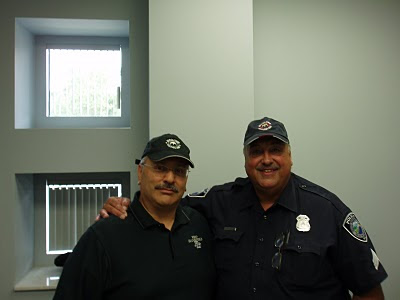What follows is some information I learned from two distinguished police officers during a work-site inservice. I want to thank the West Bloomfield police department for having two of their finest men present the information at an inservice entitled, "Service Provider Safety And Security". Thank you, Officer Rick Trabulsy and Sgt. Tom Keilman. I appreciate both of you giving me your verbal permission to write this article for my website.
 Thank you for supporting Stooltime Counseling, Officer Rick Trabulsy and Sgt. Tom Keilman! I am honored.
Thank you for supporting Stooltime Counseling, Officer Rick Trabulsy and Sgt. Tom Keilman! I am honored.VICTIMIZATION OVERVIEW:
The offender has a plan. It includes the desire, opportunity and ability to commit a crime.
The desire is connected to the criminal's observations of potential victims. No matter where we go, criminals are observing their potential victims. It could be at the grocery store, where 90% of the shoppers are female, who carry purses. It could be the garbage man or mail man, who can sell our personal information to criminals.
The opportunity is related to the criminal making contact with the victim. Approach tactics are used to get close to an intended victim.
The stranger approach happens in a moment. The victim does not know the criminal in this scenario. Purse snatchings, muggings or car jackings are some examples.
The casual approach takes time to develop. This could be the "nice" man who meets an unsuspecting female victim on the internet, develops her trust by wining and dining her and then robs her blind by stealing her credit cards or something similar.
The family approach is related to situations concerning domestic violence. Abuse or neglect of any kind underscores the family approach of the criminal.
The ability to commit a crime is connected to the actual confrontation with the victim. To stop the criminal from getting to this part of their plan, a potential victim needs to eliminate the criminal's opportunity. Whoever has the best plan, wins.
DEVELOPING A TACTICAL PRESENTATION:
The best defense is a good offense.
Be aware of your surroundings.
Dress to win.
Implement assertive body language by walking with a purpose and making eye contact with strangers. For example, the incidence of shop lifting or retail fraud is greatly reduced when store employees make eye contact with customers as they enter the store.
Think two or three steps ahead at all times so the criminal has less of an opportunity to use the element of surprise.
Have an inventory of aggressive verbal responses if confronted by a criminal. Yell to draw attention. Use simple words like, "Stop", "Fire", "Get back", "No" or "911". Avoid using the word, "Rape", because bystanders could turn a deaf ear for fear of getting involved in something that doesn't concern them.
Trust your intuition or 6th sense when out in public. A denial of potential danger is the greatest enemy of intuition. Be aware!
Train to win or have a positive view of escaping potential danger. Have a plan and practice it. Visualize yourself winning against the criminal. Evaluate/adapt your plan as needed.
Another key to safety is to take someone with you when going out in public like the shopping mall.
ENEMIES OF THE CRIMINAL:
Extended time: A criminal wants to do a crime fast. Locking your doors (car, home) and having an alarm system extends the time needed to commit a crime. This doesn't mean the criminal stops being a criminal. Crime prevention is a fallacy. However, by extending the time needed to commit a crime, the crime is moved somewhere else because the criminal then looks for the opportunity to commit a crime elsewhere.
Light: From dusk to dawn, have some kind of lighting turned-on in your home. Avoid walking in dark areas on the street.
Noise: Alarms, horns, whistles, and yelling all draw attention to the criminal. Drawing attention is something the criminal does not want during the commission of a crime.
DEFENSIVE TACTICS, STRATEGIES AND SKILLS:
The goal of a potential victim is to ESCAPE a dangerous situation.
It is a personal choice to use a counter attack to defend yourself or not defend yourself, based on the circumstances. You must have confidence in yourself and your abilities if you choose the former.
To repeat, the goal is to get away, to escape. If you choose to defend yourself, your counter attack must be quick and vicious.
FACTORS TO CONSIDER IF YOU ARE ASSAULTED:
The assailant is probably stronger than you, and may have a weapon.
The assailant has the advantage of surprise.
The assailant has picked the time and location of the attack.
The attacker will intimidate with threats of injury or other consequences.
Your fear may paralyze your thinking and response.
If your attacker is armed with a weapon DO NOT resist, but if it is your life, do what is necessary.
If you are confronted by multiple assailants, resist only if absolutely necessary.
If an attacker is after property, give it up! Resisting may make the encounter escalate.
Avoid being taken to a second crime scene/location.
ESCAPE CONSIDERATIONS AND TACTICS:
Run to safety, not away from danger.
Do not hesitate when it comes to escaping.
Get objects (like a car) or noise (blow a whistle, yelling, car horn) between you and the assailant. Do whatever is necessary to draw attention to yourself.
Hide only if your general location is unknown, if there are numerous available options to go, or if help is not near.
Keep thinking ahead. Re-evaluate your plan as needed.
Your best weapons are your awareness and a good tactical presentation.
Learning self-defense skills:
If you are able to learn self-defense skills (martial arts, other training), by all means, get the training. Learning and practicing self-defense skills helps improve your confidence so you can develop a plan to help you escape from dangerous situations.
Be safe!
Written by,
Mark Rogers, LPC.
Licensed Professional Counselor
(6/10).















No comments:
Post a Comment